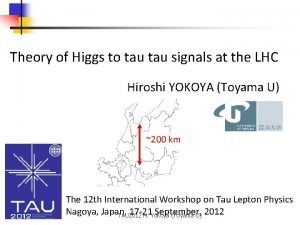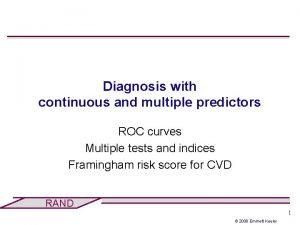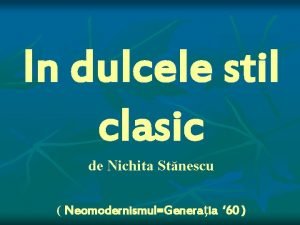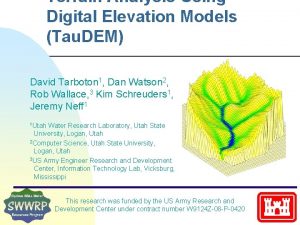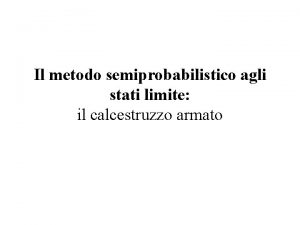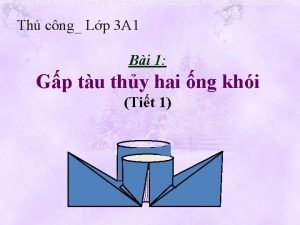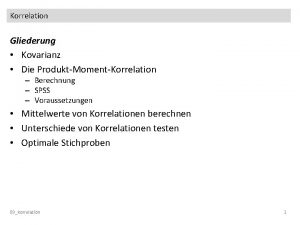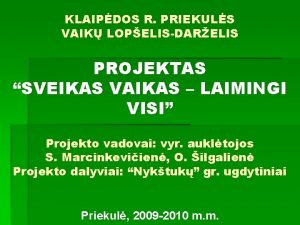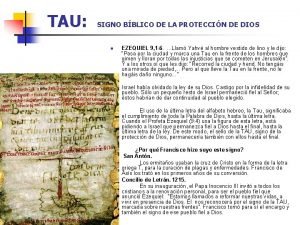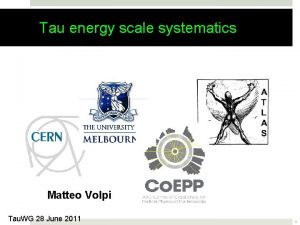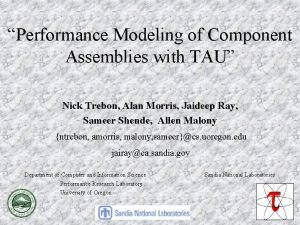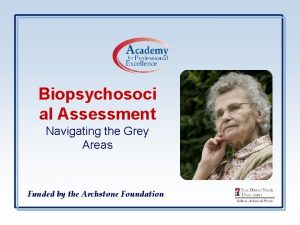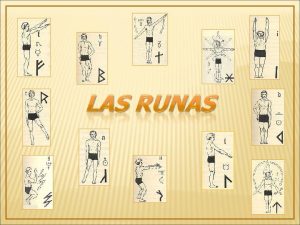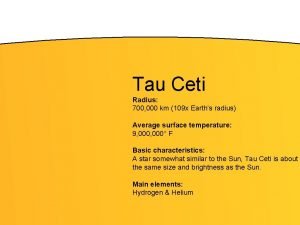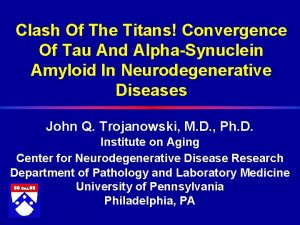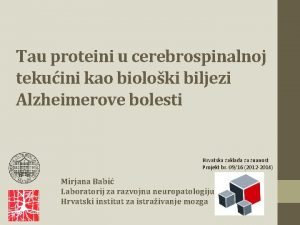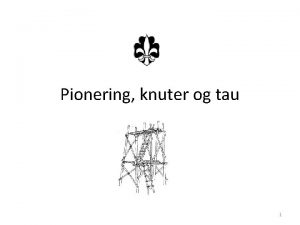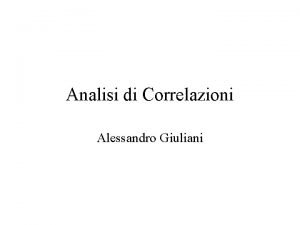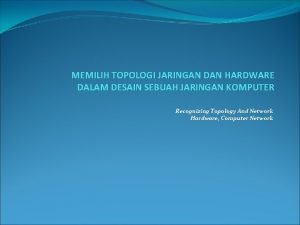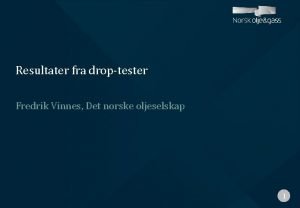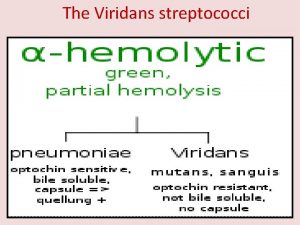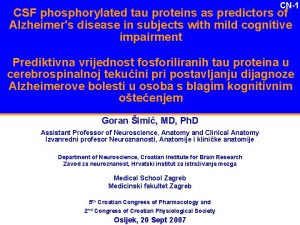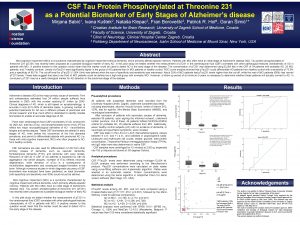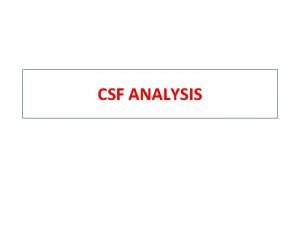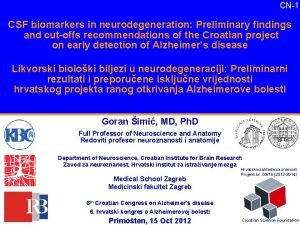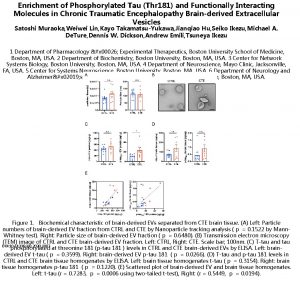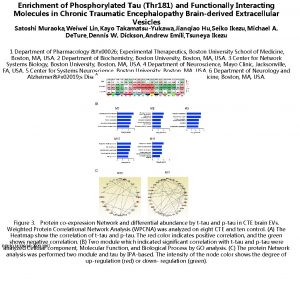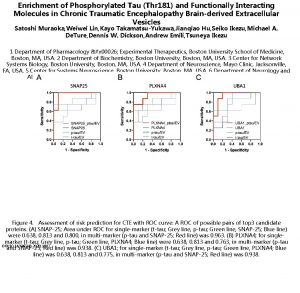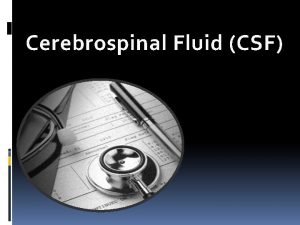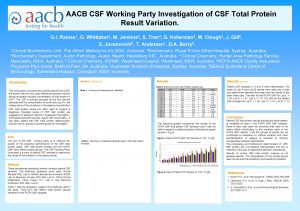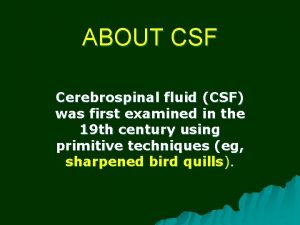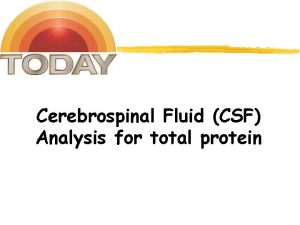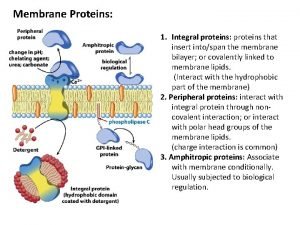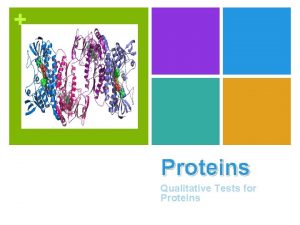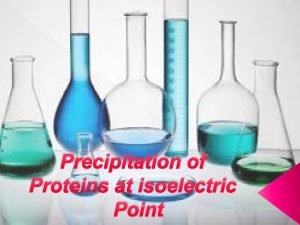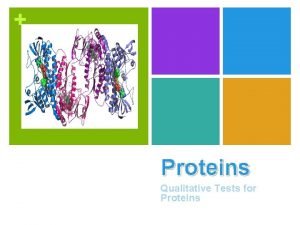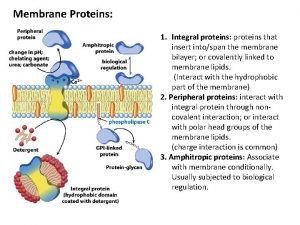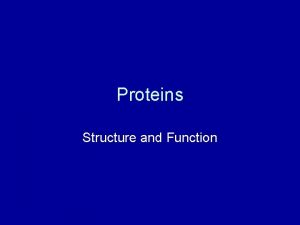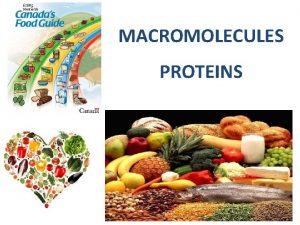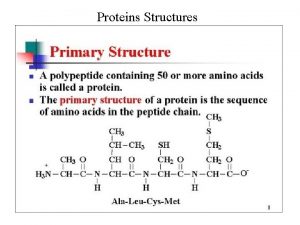CN1 CSF phosphorylated tau proteins as predictors of








































- Slides: 40

CN-1 CSF phosphorylated tau proteins as predictors of Alzheimer's disease in subjects with mild cognitive impairment Prediktivna vrijednost fosforiliranih tau proteina u cerebrospinalnoj tekućini pri postavljanju dijagnoze Alzheimerove bolesti u osoba s blagim kognitivnim oštećenjem Goran Šimić, MD, Ph. D Assistant Professor of Neuroscience, Anatomy and Clinical Anatomy Izvanredni profesor Neuroznanosti, Anatomije i kliničke anatomije Department of Neuroscience, Croatian Institute for Brain Research Zavod za neuroznanost, Hrvatski institut za istraživanje mozga Medical School Zagreb Medicinski fakultet Zagreb 5 th Croatian Congress of Pharmacology and 2 nd Congress of Croatian Physiological Society Osijek, 20 Sept 2007

Differential diagnosis of primary causes of dementia syndrome: CN-2 lines thickness is proportional to strength of association, and key anatomical regions are written in capital letters Dd primarnih uzroka sindroma demencije: debljina linija proporcionalna je jačini povezanosti, a ključna anatomska područja otisnuta su velikim slovima Ball, 1977: AD = hippocampal dementia

CN-3

CN-4 Eksplozija nasljednih tauopatija: kako definirati bolest? è HDDD (hereditary dysphasic dishinhibition dementia) è FTDP-17 (frontotemp. demencija s parkinsonizmom) è DDPAC (disinhibition dementia parkinsonism amyotrophy complex) è FMT (familial multisystem tauopathy) è SLBAD (schizophrenia-like behavior with amygdala degeneration). . . P 301 L

POSTMORTAL CRITERIA - Silver stain (Ag. NO 3) CN-5 POSTMORTALNI KRITERIJI - Srebrno bojenje sa srebrnim nitratom (Bielschowsky, 1902) Modification of Bielschowsky stain Since Alzheimer’s times, pathological substrates of AD didn’t change…

CN-6 Alzheimer’s Disease – Pathology Alzheimerova bolest - Patologija Neuritic plaques (NPs) Neurofibrillary tangles (NFTs) Modification of Bielschowsky stain Plaques and tangles . . . what has changed is our thinking about their content, localization, importance and development.

NIA diagnostic neuropathological criteria CN-7 NIA dijagnostički neuropatološki kriteriji (Khachaturian ZS, Arch Neurol, 1985) u First, it was thought that only SPs matter: criteria were based on quantification of minimal SPs cortical densities Campbell-Switzer-Martin stain u However, these first NIA criteria were not accepted because: 1. Clinical history and NFTs were not considered 2. SPs were shown to be partly a benign age-related phenomenon

CN-8 Broj ili volumen plakova ne koreliraju s težinom kliničke slike demencije u AD Braak H, Braak E. 1991

CN-9 (Mirra SS et al. , Neurology 1991) u Semiquantitative assessment of NPs in sup. temp. gyrus, prefrontal cx and lower pariet. lobule u 3 levels of dg certainty (definite, probable, possible AD) u Combination of clinical history and NPs score Major weaknesses: 1. Rely exclusively upon amyloid cascade hypothesis 2. Do not consider neocx NFTs, which correlate best with dementia severity (Bierer L et al. , Arch Neurol 1995) 3. Hippocampal formation is absent from criteria

CN-10 Broj neurofibrilarnih snopića pokazuje dobru korelaciju s težinom demencije u AD Braak H, Braak E. 1991

NIA-RI neuropathological criteria for AD CN-11 NIA-RI neuropatološki kriteriji za AD (Reagan Institute, 1997) u Reconciliate the amyloid cascade hypothesis with the major role of NFTs in clinico- pathological correlations u Include semiquantitative assessment of AD lesions in hippocampus, susbstantia nigra and locus coeruleus u Integrate CERAD and Braak staging evaluating “likelihood” AD changes led to dementia (Braak and Braak, Acta Neuropathol 1991; Neurobiol Aging. 1997; 18(4 suppl): S 1 -2. ) • High - CERAD frequent / Braak V or VI • Intermediate - CERAD moderate / Braak III or IV • Low - CERAD sparse / Braak I or II Major weakness: 1. Since there is a considerable number of demented patients with AD who have low numbers of neocx NFTs NIA-RI criteria are more specific than CERAD, but LESS SENSITIVE

CN-12 AD pathogenesis - Current mainstream thinking (in f. AD) Patogeneza AD - Trenutno stanje (Vickers et al. , Prog. Neurobiol. 2005) Genetics (f. AD) diffuse A deposits (alpha helix structure) fibrillogenesis - beta strand (sheet) (accelerated by Cu 2+, Zn 2+, HSV? …) http: //talaga. rutgers. edu/research/images SPs . . causes physical obstruction of axoplasmic flow,

CN-13 . . . resulting in axonal sprouting, tau mobilization and excessive tau phosphorylation NFTs + NPs (best clinicopathological correlation) NFTs s. AD? NFT NP NFT An inappropriate re-expression or re-activation of developmentally regulated protein kinase(s) (e. g. fetal 100 k. Da protein kinase that phosphorylate Ser 262) could contribute to the abnormal phosphorylation of tau, and thus play a role in pathogenesis of AD NPs Bielschowsky stain

AD Pathologic Change in Non-Demented Elderly CN-14 Patol. promjene karakteristične za AD u nedementnih starijih osoba (Knopman et al. J Neuropathol Exp Neurol 2003) u 39 longitudinally followed non-demented cases • Mean age 85 years (74 - 95) – AD pathologic change: • 38 Braak stage I or greater, 4 Braak stage IV or V • 37 with sparse or absent neuritic plaques, ~50% with moderate to frequent diffuse plaques CONCLUSION: We still don’t have definitive neuropathological criteria; for now… – “. . . cut off point should be set to Braak stage ? (≥ IV)”

CN-15 Nagao prijelaz zbog superponiranog age-associated gubitka sinapsi i neurona

Clinicopathological correlation Kliničkopatološka korelacija CN-16

CN-17 Current approaches to early assessment of MCI to AD conversion Današnjie mogućnosti u ranoj dijagnostici konverzije MCI u AD u Early concern (ADI 10 warning signs) www. alzheimer. hr u Dementia severity psychological assessment tools (lack early power) u Positive diagnostic tests (too invasive for screening): 1. CSF – tau levels elevated, BA levels low 2. Structural MRI (hipp. & entorh. cx lower volumes, whole cx) 3. F-nal PET brain scan (FDGlucose, NFTs: DDNP, BA: Thioflavin-S, Congo-red derivatives)

Herrmann et al. Eur Neurol ‘ 99 CN-18

Herrmann et al. Eur Neurol ‘ 99 CN-19 Category 0 – absence of NFT (ICC) Category 1 – presence of NFT (ICC)

CN-20 .

CN-21 Cave!

CN-22 Ptau 231 =94% sensitive, 64% specific AD vs FTD; similar numbers shown for LBD Hampel H et al. Measurement of phosphorylated tau epitopes in the differential diagnosis of Alzheimer’s disease: A comparative cerebrospinal fluid study. Arch Gen Psychiat 2004; 61: 95 -102.

CN-23 Fox et al. Lancet ‘ 04

CN-24

CN-25

CN-26 + Nordberg A. et al. Lancet Neurology 2004

CN-27

CN-28 AD – parijetotemporalni hipometabolizam 18 -Fluoro-2 -deoksi. D-glukoza (18 FDG) PET KBC Rebro Ljubazno ustupio za korištenje dr. Ratimir Petrović

CN-29 Je li moguće povećati specifičnost CSF biomarkera?

CN-30 Je li moguće povećati specifičnost CSF biomarkera? Teško, jer…

CN-31 Major pitfall u The major pitfall when studying CSF biomarkers to predict AD in MCI cohorts is the fact that conversion from MCI to AD is only about 12 -15% per year (in contrast, only 1 -2% of healthy older population convert to AD per year), whereas the rest of MCI patients have a less progressive form of memory impairment (De. Carli, Lancet Neurol ’ 03; Petersen, J Int Med ’ 04) u Therefore, only an extensive follow-up time (>5 years) of patients with stable MCI might further increase the specificity of CSF biomarkers!

CN-32 Kako spriječiti nastanak F 3 fragmenta? F 3

CN-33 Since tau proteins behave differently in different neurodegenerative conditions…

CN-34 …they represent the future of neurodegenerative disease diagnosis 4 R = 3 R Type I Aging GSS PDC Guam, etc. 4 R > 3 R Type II 3 R > 4 R Type III Type I Familial multisyst. tauopathy AGD Pallido-ponto-nigral degeneration, etc. . more accurate analysis of CSF helps to discriminate between tau protein types present in physiological conditions and tau released during the progression of a particular neurodegenerative disease

CN-35 Pattern of some tau Mabs, their epitopes, putative kinases and the respective cellular pathology (s. AD? ) pre-tangle stage intracell. tangle extracell. tangle

CN-36 MCI to AD Selective phospho-tau epitopes were recently shown to be the best for detection of MCI to AD conversion! Urakami, Psychogeriatrics ‘ 06

CN-37 Multidimensional cluster analysis using all available biological and psychometric data P-tau S 181 AD vs DLBD: 91% sens. 94% specif. T-tau AD vs VD: 91% sensitivity, 95% specificity 1 AD, 2 CBD, 3 FTD, 4 Va. D, 5 MCI, 6 ND

CN-38

CN-39 Sažetak: CSF biomarkeri

CN-40 Hvala na pažnji! Pitanja? Posjetite: www. alzheimer. hr http: //dementia. hiim. hr
 Higgs to tau tau
Higgs to tau tau Roc curve with multiple predictors
Roc curve with multiple predictors Pasul tau de domnisoara
Pasul tau de domnisoara Tau beta sigma mission statement
Tau beta sigma mission statement Taudem
Taudem Sigma ammissibile
Sigma ammissibile Hong kong public housing floor plan
Hong kong public housing floor plan Gấp tàu thủy hai ống khói
Gấp tàu thủy hai ống khói Letra tav significado
Letra tav significado Kendalls tau wertebereich
Kendalls tau wertebereich Labas rytas tau galvyte
Labas rytas tau galvyte Signo franciscano
Signo franciscano Texto de luison en guarani
Texto de luison en guarani Malanga fakaosi tau
Malanga fakaosi tau Tau energi
Tau energi Proxy tau
Proxy tau Whakataka te hau
Whakataka te hau Sen tau
Sen tau Letra grega mu
Letra grega mu Delta tau alpha agricultural honor society
Delta tau alpha agricultural honor society Un templu sfant versuri
Un templu sfant versuri Myliu tave mamyte
Myliu tave mamyte Tau tangles
Tau tangles Tyr runa
Tyr runa Tau ceti distance to earth
Tau ceti distance to earth Tau vs titans
Tau vs titans Kia tau kia tatou katoa karakia
Kia tau kia tatou katoa karakia E rongo karakia translation
E rongo karakia translation Tau ceti e
Tau ceti e Tau relational algebra
Tau relational algebra Tau proteini
Tau proteini Tetrathlon olympics
Tetrathlon olympics Langspleis tau
Langspleis tau Kendall's tau formula
Kendall's tau formula Tizen advanced ui
Tizen advanced ui Kriteria memilih topologi
Kriteria memilih topologi Tàu caraven
Tàu caraven Elastisk tau biltema
Elastisk tau biltema Allah maha tau
Allah maha tau Csf reabsorption
Csf reabsorption Draughtsman colonies
Draughtsman colonies
